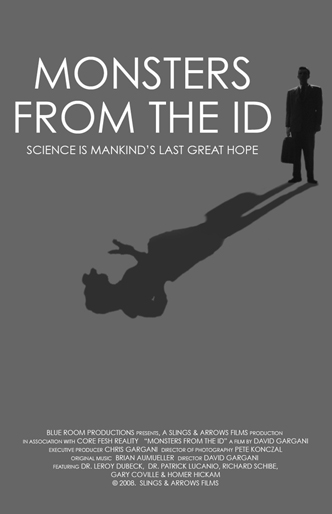#35) Movie Review (sort of): “Monsters from the Id”
May 3rd, 2010
On Saturday I was on a panel discussion of a documentary titled, “Monsters from the Id.” It was organized by Jennifer Ouellette, head of the National Academy of Sciences Science and Entertainment Exchange — a program for which I am a huge fan. It was also part of the Los Angeles United Film Festival held at the Los Feliz theaters.
For the post-screening panel discussion, I was intellectually dwarfed by two superstar scientists — Kristin Baldwin who studies stem cells at Scripps Research Institute and Kevin Hand of JPL who is trying to figure out how big of fish we can expect to encounter on the planet Europa, the sixth moon of Jupiter, when we finally send people there. Both of them are extremely articulate and communicationally (a word?) adept.

"It id what it id"
The film was 70 minutes. The first half hour was kinda weak — hitting the same note over and over about how wacky science fiction movies were in the 1950’s. It really wasn’t going anywhere and I was thinking, “This is why filmmakers should go to film school,” but when it finally made it out of the 50’s and into the space race of the 60’s it began to gain a little more content and became a little more clear that the filmmaker really did have something to say.
I think the “message” for me finally came together when, after showing countless shots of hokey looking spacemen in their space suits from all the crazy sci fi flicks, they began showing real human beings in real space suits boarding real rockets and eventually really walking on the moon. In those moments it actually did an impressively good job (at least for me) of making the journey from fantasy to fact, which was pretty cool.
It just seemed to be saying, “Look at how much crazy imagination was unleashed on the idea of space travel in the 1950’s, and yet, lo and behold, a certain amount of that fantasy actually did come true.” I think to this day it’s still difficult for people to fully process how amazing it was that humans made it to the moon. This film helped convey that (though the music scoring gave me a little bit of a headache).
By the end it definitely was a cool film, but left you a bit depressed with today’s world where walking on the moon has become a distant memory for manned exploration of space. The movie even showed how much the budget of NASA has declined in recent years. Clearly the glory days ended in the 1970’s. Just like for movies, which is what I was thinking about as I watched it — I was thinking of the great, great documentary, “Easy Riders and Raging Bulls,” which shows you how amazingly creative Hollywood was in the 1970’s, but it all ended when the 80’s rolled around and the business community took over. The very best moment of that film is towards the end where a woman (can’t remember who, I think she was a producer) says it all ended in a single weekend — all the creativity and energy and experimentation — it all ended the first weekend that Hollywood began announcing the box office totals for the top ten movies. From then on, it was no longer about telling great stories but rather making great amounts of money, culminating in today’s Hollywod obsession with “tent pole” movies that are utterly vacuous but make boatloads of money for all involved.
And just to underscore that point, Harpers magazine last month in its list of factoids had the following: “Average box office return for movies last year costing over $100 million to make: $350 million”
Today the whole system has degenerated into Hollywood redefining the word “original” as described in this sad (but certainly true) blogpost about how Hollywood folks are desperate for “original” ideas for movies so long as they’re based on “an existing comic book, video game or novel.”
Anyhow, “Monsters from the Id” was reasonably interesting, but as someone pointed out in the discussion, there wasn’t really much discussion about monsters from the id. It was mostly about how the glory days ended in the 70’s and we should think about getting back to that mindset some day.